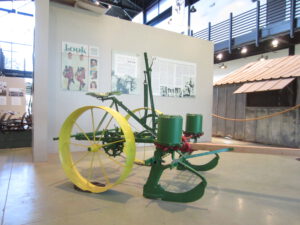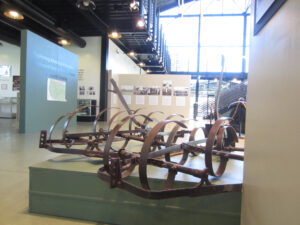When the Visalia Historical Society learned about a collection of historical farm pieces left outside Mooney Grove, they decided to recruit high schoolers to restore the equipment as an educational project. After working for a year to sort through the collection, the group decided to keep and preserve around 150 of the items for the public to view in the Mooney Grove museum.

The Historical Society recruited local high school and community college students to work on the equipment turning the project into a learning opportunity. They reached out to the instructors of the agriculture departments of different schools in the Valley and found candidates to take on the restoration.
The Historical Society required a highly thorough process for each group hoping to take part in this project: before the process of restoration, they asked interested students and teachers to sign an agreement stating they would do in-depth research into the piece of equipment they received.
According to Carl Switzer, a Historical Society member, “The point of the loan is to make the repair a learning experience.” This involved digging through documents in local libraries to determine each item’s origin, use, original appearance, and organize the information into an academic paper and a placard for the museum to use when the item went on display. Because the pieces dated all the way back to the 1800s and early 1900s, this was no easy task—the kids worked with librarians and agriculture experts to find the documentation they needed in old books and periodicals.
Once students had all the necessary info on the item of equipment they hoped to restore, they began the process of preserving it for the future, which involved taking the piece apart and cleaning each components, which were often covered in rust and other debris after being in the elements for so long. After completing the primary cleaning, students contacted the Historical Society with a list of materials needed for full restoration, such as paint, steel, wood, tools, or individual components the equipment was missing. The Historical Society funded all purchases to put the parts into original condition out of their budget in the interest of supporting the project.

Unfortunately, before many students could make much progress on the process of restoration, the COVID-19 pandemic began and caused schools to turn to distanced learning. As a result, the project came to an abrupt halt in March of 2020. When schools opened back up in January of 2021, several schools were able to complete their projects and return the pieces back to the museum. The fully restored equipment is on display in the History of Farm Labor and Agriculture Museum in Mooney Grove Park, along with information on the students who restored it, the process of preserving it, and its original use in the Central Valley agriculture industry.
Now that schools are open again, students will continue researching and restoring equipment for the citizens of Central Valley to learn about at the museum. The historical significance of the pieces is no small concept: in Switzer’s words, “The reason that equipment came into being was because it would make the job easier for the farmer. Back in the early days, the late 1800s, a lot of the work was simply done by farmers by hand… I think that there was driving motivation to come up with better equipment that would do it faster and easier and more efficiently.”
Thanks to the work of the Historical Society and local agriculture students, museum goers can learn about the evolution of the local agriculture industry, and preserve the historical pieces for years to come.

Its the “Tulare County Historical Society”